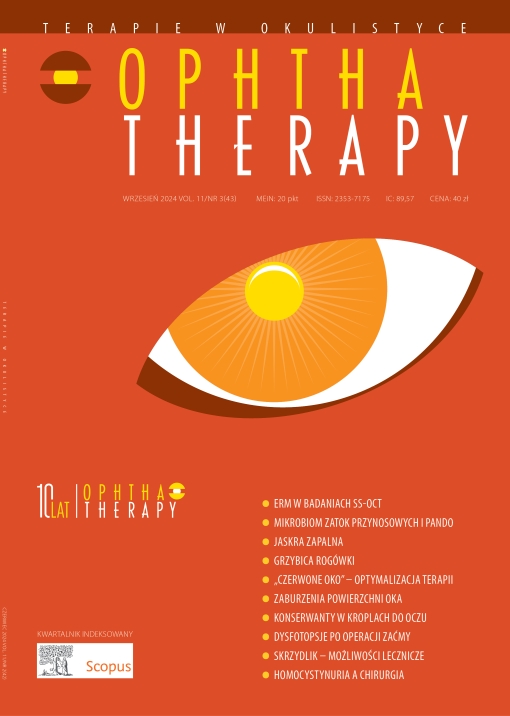Eye-drops in therapy – facts and myths about preservatives Review article
Main Article Content
Abstract
Drugs in ophthalmology are most often applied topically in the conjunctival sac. All preparations administered through this route must meet specific requirements and, therefore, not just a simple solution or suspension of the drug in water. In addition to the therapeutic substance, eye drops contain various additives: buffers, preservatives, stabilisers, antioxidants, and isotonic substances to increase solubility and viscosity. Excipients are essential components of drugs that determine their quality and properties and can increase the effectiveness of treatment, e.g. by increasing the penetration of the drug through biological barriers. However, because of the high demands placed on ocular medicines, the choice of excipients is very limited.
This article discusses the facts and myths surrounding the use of excipients, including preservatives, in eye drops.
Downloads
Article Details
Copyright: © Medical Education sp. z o.o. License allowing third parties to copy and redistribute the material in any medium or format and to remix, transform, and build upon the material, provided the original work is properly cited and states its license.
Address reprint requests to: Medical Education, Marcin Kuźma (marcin.kuzma@mededu.pl)
References
2. Bennett NH, Chinnery HR, Downie LE et al. Material, Immunological, and Practical Perspectives on Eye Drop Formulation. Adv Funct Mater. 2020; 30: 1908476.
3. Kluk A, Sznitowska M. Substancje pomocnicze w kroplach do oczu. Farm Pol. 2010; 66(8): 567-72.
4. Pescina S, Carra F, Padula C et al. Effect of pH and penetration enhancers on cysteamine stability and trans-corneal transport. Eur J Pharm Biopharm. 2016; 107: 171-9.
5. Kahook MY, Rapuano CJ, Messmer EM et al. Preservatives and ocular surface disease: A review. Ocul Surf. 2024; 34: 213-24.
6. Dutescu RM, Panfil C, Schrage N. Osmolarity of prevalent eye drops, side effects, and therapeutic approaches. Cornea. 2015; 34(5): 560-6.
7. Pena-Verdeal H, Garcia-Queiruga J, García-Resúa C et al. Osmolality and pH of commercially available contact lens care solutions and eye drops. Cont Lens Anterior Eye. 2021; 44(4): 101379.
8. Freeman PD, Kahook MY. Preservatives in topical ophthalmic medications: historical and clinical perspectives. Expert Rev Ophthalmol. 2009; 4(1): 59-64.
9. Louati Y, Shaarawy T. Controversy: Is Benzalkonium Chloride Necessary in Antiglaucoma Drops? J Curr Glaucoma Pract. 2012; 6(3): 104-7.
10. Noecker R. Effects of common ophthalmic preservatives on ocular health. Adv Ther. 2001; 18(5): 205-15.
11. Tu EY. Balancing antimicrobial efficacy and toxicity of currently available topical ophthalmic preservatives. Saudi J Ophthalmol. 2014; 28(3): 182-7.
12. Walsh K, Jones L. The use of preservatives in dry eye drops. Clin Ophthalmol. 2019; 13: 1409-25.
13. Wirta D, Malhotra R, Peace J et al. Noninferiority Study Comparing Latanoprost 0.005% Without Versus With Benzalkonium Chloride in Open-Angle Glaucoma or Ocular Hypertension. Eye Contact Lens. 2022; 48(4): 149-54.
14. Jumelle C, Gholizadeh S, Annabi N et al. Advances and limitations of drug delivery systems formulated as eye drops. J Control Release. 2020; 321: 1-22.
15. Steven DW, Alaghband P, Lim KS. Preservatives in glaucoma medication. Br J Ophthalmol. 2018; 102(11): 1497-503.
16. Hedengran A, Steensberg AT, Virgili G et al. Efficacy and safety evaluation of benzalkonium chloride preserved eye-drops compared with alternatively preserved and preservative-free eye-drops in the treatment of glaucoma: a systematic review and meta-analysis. Br J Ophthalmol. 2020; 104(11): 1512-8.

